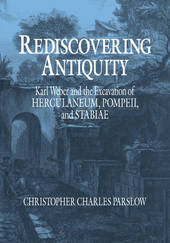
|
Rediscovering Antiquity: Karl Weber and the Excavation of Herculaneum, Pompeii and Stabiae
Paperback / softback
Main Details
| Title |
Rediscovering Antiquity: Karl Weber and the Excavation of Herculaneum, Pompeii and Stabiae
|
| Authors and Contributors |
By (author) Christopher Charles Parslow
|
| Physical Properties |
| Format:Paperback / softback | | Pages:418 | | Dimensions(mm): Height 254,Width 178 |
|
| Category/Genre | Ancient and classical art BCE to c 500 CE
Classical Greek and Roman archaeology |
|---|
| ISBN/Barcode |
9780521646642
|
| Classifications | Dewey:937.7 |
|---|
| Audience | | Tertiary Education (US: College) | | Professional & Vocational | |
|---|
| Illustrations |
Worked examples or Exercises
|
|
Publishing Details |
| Publisher |
Cambridge University Press
|
| Imprint |
Cambridge University Press
|
| Publication Date |
13 October 1998 |
| Publication Country |
United Kingdom
|
Description
Examines the early history of the excavations at three important sites of classical antiquity, which came to light in 1738 through the life and work of Karl Jakob Weber, who supervised these investigations from 1750 to 1765. While many of his contemporaries sought only the recovery of precious antiquities to the exclusion of the architectural remains, Weber sought to retrieve evidence of the ancient urban fabric and to relate his discoveries to their archaeological context, thereby establishing the first systematic approach for the excavations. He also proposed a revolutionary manner for publishing his findings, in which all of the works of art from an individual site would appear together with detailed plans, drawings, and commentary drawn from classical and modern sources. His methods were to influence all subsequent publications of contemporary rediscoveries throughout Europe. Based on original excavation documents and plans, contemporary correspondence and the extant archeological remains.
Reviews' ... this book provides valuable material for those studying the archaeology of the Vesuvian sites and those concerned with the role of these sites in the creation of the eighteenth-century classical tradition in Europe.' Ray Laurence, The Classical Review
|